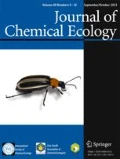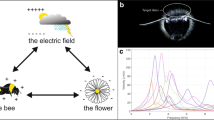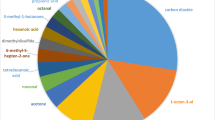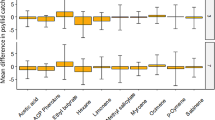Abstract
Olfactometer bioassays and electrophysiological studies showed that the lacewing, Chrysopa sinica, the aphid parasitoid, Aphidius sp., and the coccinellid, Coccinella septempunctata, all responded to volatiles from tea aphids, Toxoptera aurantii, to hexane or ether rinses of tea aphid cuticles, and to synomones released by aphid-damaged tea shoots, as well as to the tea shoot–aphid complex. Each natural enemy spent more time searching on a filter paper treated with tea aphid honeydew than on a blank control filter paper. The interaction between synomones from aphid-damaged shoots and kairomones from tea aphids enhanced the responses to the plant–host complex. There was a significant, logistic dose–response relationship between the number of natural enemies responding and the odor stimulus concentration. Volatile components from the plant–host complex, obtained by air entrainment, were identified by their mass spectra and retention times and confirmed by comparison with standard samples. These were (Z)-3-hexen-1-ol, benzaldehyde, (E)-2-hexenal, (Z)-3-hexenyl acetate, ocimene, linalool, geraniol, indole, and (E)-2-hexenoic acid. The main components in a hexane rinse from tea aphid cuticle were benzaldehyde, undecane, 2,5-hexanedione, 2,5-dihydrothiophene, linalool, 4-methyl-octane, and eicosane, whereas the main components from an ether rinse were (E)-2-hexenoic acid, heptadecane, pentadecane, eicosane, tetratetracontane, and nonadecane. Benzaldehyde elicited the strongest responses from natural enemies in the olfactometer and the largest electroantennogram (EAG) responses. While the amount of odor was small, Coccinella septempunctata was slightly more sensitive than Chrysopa sinica and Aphidius sp. An increase in doses of benzaldehyde, (E)-2-hexenal, and (Z)-3-hexenyl acetate caused the EAG responses of each natural enemy to decrease. When the doses of (Z)-3-hexen-1-ol, linalool, and geranoil increased, EAGs of Chrysopa sinica and Aphidius sp. increased, but EAGs of Coccinella septempunctata decreased. When the dose of indole increased, EAGs of Coccinella septempunctata decreased, but those of Aphidius sp. increased. This study demonstrates that tea shoot–aphid complexes emit volatile synomones, while the odors from tea aphids, aphid cuticle extracts, and tea aphid honeydew contain kairomones, to which the natural enemies show a logistic dose–response.
Similar content being viewed by others
REFERENCES
Bakthavatsalam, N., Singh, S. P., Tandon, P. L., Chaudhary, M., and Preethi, S. 1999. Behavioural responses of key parasitoids of Opisina arenosellaWalker (Lepidoptera: Noctuidae) to the kairomones. J. Biol. Control 13:7–14. 2218 HAN AND CHEN
Bakthavatsalam, N. and Singh, S. P. 1996. L-tryptophan as an ovipositional attractant for Chrysoperlacarned (Stephens) (Neuroptera: Chrysopidae). J. Biol.Control 10:21–22.
Bouchard, Y. and Cloutier, C. 1984. Honeydew as a source of host-searching kairomones for the aphid parasitoid Aphidius nigripes (Hymenoptera: Aphidiidae).Can. J. Zool. 62:1513–1520.
Budenberg, W. J. and Powell, W. 1992. The role of honeydew as an ovipositional stimulant for two species of syrphids. Entomol. Exp. Appl. 64:57–61.
Carter, M. C. and Dixon, A. F. G. 1984. Honeydew: an arrestant stimulus for coccinellids. Ecol. Entomol. 9:383–387.
Das, S. C. and Kakoty, N. N. 1992. Biological studies on tea aphids, Toxoptera aurantii Boyer, and its natural enemy complex. Two A Bud 39:29–33.
Davis, R. H. and Nahrstedt, A. 1985. Cyanogenesis in insects, pp. 635, in G. A. Kerkui and L. I. Gilbert (eds.). Comprehensive Insect Physiology, Biochemistry and Pharmacology, Vol. 11. Pergamon Press, Oxford.
Dicke, M. 1994. Local and systemic production of volatiles herbivore-induced terpenoids: Their role in plant–carnivore mutualism. J. Plant Physiol. 143:465–472.
Du, Y. J., Poppy, G. M., and Powell, W. 1996. Relative importance of semiochemicals from first and second trophic levels in host foraging behavior of Aphidius ervi. J. Chem. Ecol. 22:1591–1605.
Du, Y. J., Poppy, G. M., Powell, W., Pickett, J. A., Wadhams, L. J., and Woodcock, C. M. 1998. Identification of semiochemicals released during aphid feeding that attract parasitoid Aphidius ervi. J. Chem. Ecol. 24:1355–1368.
Duffey, S. S. 1981. Cyanide and arthropods, p. 385, in B. Vennesland, E. E. Conn, C. J. Knowles, J. Westley, F. Wissing. (eds.) Cyanide in Biology. Academic Press, London.
FrÖhlich, B., Tautz, J., and Riederer, M. 2000. Chemometric classification of comb and cuticular waxes of the honeybee Apis mellifera carnica. J. Chem. Ecol. 26:123–137.
Guerrieri, E., Pennacchio, F., and Tremblay, E. 1993. Flight behaviour of the aphid parasitoid Aphidius ervi (Hymenoptera: Braconidae) in response to plant and host volatiles. Eur. J. Entomol. 90:415–421.
Guo, W. F., Sasak, N., and Fulcuda, M. 1998. Isolation of an aroma precursor of benzaldehyde from tea leaves (Camellia sinensis var. sinensis w. yabukita). Biosci. Biotechnol. Biochem. 62:2052–2054.
Han, B. Y. 2002. Population dynamics of tea aphid, Toxoptera aurantii, and its natural enemies in tea garden. J. Tea Sci. 22(2).
Han, B. Y. and Chen, Z.M. 2000. Searching behavior of Coccinella septempunctata and four varieties of Leis axyridis adults on tea aphid honeydew and analysis of honeydew component. Acta Ecol. Sin. 20:495–501. (in Chinese with English Abstract).
Han, B. Y., Zhang, Z. N., and Fang, Y. L. 2001. Electrophysiology and behavior feedback of diamondback moth, Plutella xylostella, to volatile secondary metabolites emitted by Chinese cabbage. Chin. Sci. Bull. 46:2086–2088.
HÖsei, W. 1981. The enzymic hydrolysis of cyanogenic glucosides, p. 217, in B. Vennesland, E. E. Conn, C. J. Knowles, J. Westley, and F. Wissing. (eds.). Cyanide in Biology. Academic Press, London.
Knudsen, J. T., Tollsten, L., and Bergstrom, L. G. 1993. Floral scents-A checklist of volatile compounds isolated by headspace techniques. Phytochemistry 33:253–280.
Koschier, E. H., Kogel, W. J. D., and Visser, J. H. 2000. Assessing the attractiveness of volatile plant compounds to western flower thript Frankliniella occidentalis. J. Chem. Ecol. 26:2643–2655.
Liepert, C. and Dettner, K. 1996. Role of cuticular hydrocarbons of aphid parasitoids in their relationship to aphid-attending ants. J. Chem. Ecol. 22:695–707.
Li, Z. X., Chen, C. M., and Tang, M. Y. 1993. Host searching kairomones of Amitus longiconis Föster. Acta Entomol. Sin. 36:45–50 (in Chinese with English abstract). RESPONSES TO TEA SHOOTS AND APHIDS 2219
Madhusudhan, V. V.,, Taylor, G. S., and Miles, P. W. 1994. The detection of salivary enzymes of phytophagous Hemiptera: a complication of methods. Ann. Appl. Biol. 124:404–412.
Micha, S. G. and Wyss, U. 1995. The importance of plant odors for the host search of Aphidius uzbekistanicus (Hymenoptera, Aphidiidae), a parasitoid of the grain aphid (Sitobion avenae). Gesunde Pflanz. 47:300–307 (in German)
Nahrstedt, A. 1985. Cyanogenic compounds as protecting agents for organisms. Plant Syst. Evol. 150:35–47.
Ninkovic, V., Abassi, S. A., and Pettersson, J. 2001. The influence of aphid-induced plant volatiles on ladybird beetle searching behavior. Biol. Control 21:191–195.
Powell, W., Pennacchio, F., Poppy, G. M., and Tremblay, E. 1998. Strategies involved in the location of hosts by the parasitoid Aphidius ervi Haliday (Hymenoptera: Braconidae: Aphidiinae). Biol. Control 11:104–112.
Park, K. C., Elias, D., Donato, B., and Hardie, J. 2000. Electroantennogram and behavioural responses of different forms of the bird cherry-oat aphid, Rhopalosiphum padi, to sex pheromone and a plant volatile. J. Insect Physiol. 46:597–604.
Reed, H. C., Tan, S. H., Haapanen, K., Killmon, M., Reed, D. K., and Elliott, N. C. 1995. Olfactory responses of the parasitoid Diaeretiella rapae (Hymenoptera: Aphidiidae) to odor of plants, aphids, and plant-aphid complexes. J. Chem. Ecol. 21:407–418.
Royer, L. and Boivin, G. 1999. Infochemicals mediating the foraging behavior of Aleochara bilineata Gyllenhal adults: sources of attractants. Entomol. Exp. Appl. 90:199–205.
Seigler, D. S. 1981. Cyanogenic glucosides and lipids: strycture types and distribution, p. 133, in B. Vennesland, E. E. Conn, C. J. Knowles, J. Westley, and F. Wissing. (eds.). Cyanide in Biology. Academic Press, London.
Shaltiel, I. and Ayal, Y. 1998. The use of kairomones for foraging decisions by an aphid parasitoid in small host aggregations. Ecol. Entomol. 23:319–329.
Sudoi, V. and Rotich, F. 1997. The rearing of hoverfly Xanthogramma aegyptium (Diptera: Syrphidae) for use as a biocontrol agent in controlling citrus aphids Toxoptera aurantii (Homoptera: Aphidae) in tea. Tea 18:42–44.
Sudoi, V., Mwangi, J., and Kipsang, D. 1996. Preliminary survey of natural enemies of citrus aphid, Toxoptera aurantii, in tea Timbilil Estate. Tea 17:50–52.
Tang, Q. Y. and Feng, M. G. 2000. Data Precessing System. Chinese Agricultural Press, Beijing.
Teulon, D. A. J., Penman, D. R., and Ramarers, P. M. J. 1993. Volatiles chemicals for thrips (Thysanoptera: Thripidae) host finding and applications for thrips pest management. J. Econ. Entomol. 86:1405–1415.
Turlings, T. C. J, Bernasconi, M., and Bertossa, R. 1998. The induction of volatiles in maize by three herbivore species with different feeding habits: possible consequences for their natural enemies. Biol. Control 11:122–129.
Vet, L. E. M., WÄckers, F. L., and Dicke, M. 1991. How to hunt for hiding hosts: the reliability–detectability problem in foraging parasitoids. Neth. J. Zool. 41:202–213.
Vet, L. E. M. and Dicke, M. 1992. Ecology of infochemical use by natural enemies in a tritrophic context. Annu. Rev. Entomol. 37:141–172.
Visser, J. H. 1979. Electroantennogram responses of the Colorado beetle, Leptinotarsa decemlineata, to plant volatiles. Entomol. Exp. Appl. 25:86–97.
Author information
Authors and Affiliations
Corresponding author
Rights and permissions
About this article
Cite this article
Han, B., Chen, Z. Behavioral and Electrophysiological Responses of Natural Enemies to Synomones from Tea Shoots and Kairomones from Tea Aphids, Toxoptera aurantii . J Chem Ecol 28, 2203–2219 (2002). https://doi.org/10.1023/A:1021045231501
Issue Date:
DOI: https://doi.org/10.1023/A:1021045231501




